 Jan. '03: First light on the 3.5m telescope at the Calar Alto observatory.
Jan. '03: First light on the 3.5m telescope at the Calar Alto observatory.
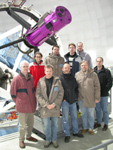 Jan. '03: First light and a happy team. From left to right: H.J. Röser
(PI), Ana Guijarro (CA staff), Peter Bizenberger (guy for everything), Mathias
Alter (control electronics), Ulrich Mall (readout electronics), Rene Fassbender
(student), Zoltan Kovacs (PhD student), Clemens Storz (software), Harald Baumeister
(mechanics). Floating on top in pink: Omega2000.
Jan. '03: First light and a happy team. From left to right: H.J. Röser
(PI), Ana Guijarro (CA staff), Peter Bizenberger (guy for everything), Mathias
Alter (control electronics), Ulrich Mall (readout electronics), Rene Fassbender
(student), Zoltan Kovacs (PhD student), Clemens Storz (software), Harald Baumeister
(mechanics). Floating on top in pink: Omega2000.
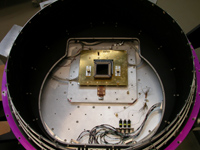 Oct. '02: Integration of the science detector. First tests.
Oct. '02: Integration of the science detector. First tests.
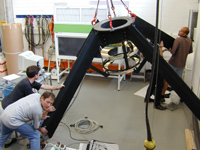 Aug. '02: Frontring and baffle test. Mr. Böhem and his team pointing
to the galactic center.
Aug. '02: Frontring and baffle test. Mr. Böhem and his team pointing
to the galactic center.
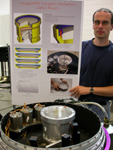 Aug. '02: Harald Baumeister preparing the poster for the SPIE conference.
Aug. '02: Harald Baumeister preparing the poster for the SPIE conference.
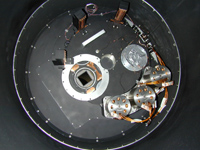 Jul. '02: Integration with the engineering detector, filters and optics.
Jul. '02: Integration with the engineering detector, filters and optics.
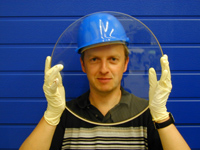 Jun. '02: Cool down with the real window (350 mm diameter). Peter Bizenberger
with an interferometric glance.
Jun. '02: Cool down with the real window (350 mm diameter). Peter Bizenberger
with an interferometric glance.
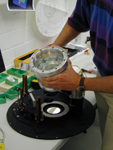 Jun. '02: Assembly of the filters and optics for first cryogenic tests.
Jun. '02: Assembly of the filters and optics for first cryogenic tests.
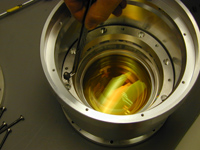 Jun. '02: Mounting the first lens (Cleartran) in the optics mount.
Jun. '02: Mounting the first lens (Cleartran) in the optics mount.
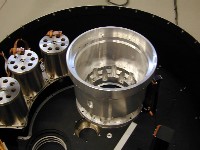 May 02: Optics mount is deliverd from Firma
Haecker, Mechanische Fertigung, Weinsberg, Germany. All dimensions in
spec. Ready for the first optics tests.
May 02: Optics mount is deliverd from Firma
Haecker, Mechanische Fertigung, Weinsberg, Germany. All dimensions in
spec. Ready for the first optics tests.
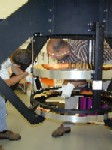 May 02: Warm baffles are delivered and are already installed thanks to Mr.
Meixner and Mr. Meister. The diamond turened sufaces are gold coated.
May 02: Warm baffles are delivered and are already installed thanks to Mr.
Meixner and Mr. Meister. The diamond turened sufaces are gold coated.
Apr. 02: Crash test dummy. Since Omega2000 makes use of all available space
(to the last centimetre) in the dome, a cardbord dummy will be used for first
telescope mounting tests. Engineered to go the limit!
Apr.
'02: Florian Briegel, software engineer, joined the Omega2000 team. He came
with a nice cake. We hired him.
Mar. '02: Science grade detector is delivered. According to the test data
sheets, the performance is very well suited to our application i.e. medium
noise, high QE, nice cosmetics.
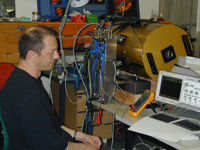 Mar.'02: Ulrich Mall tries hard to optimize the readout electronics. We are
learning the HAWAII-2 problems.
Mar.'02: Ulrich Mall tries hard to optimize the readout electronics. We are
learning the HAWAII-2 problems.
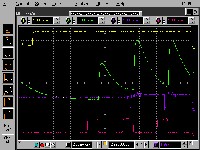 Mar. '02: Readout patterns are generated and optimized. We are learning the
HAWAII-2 performance.
Mar. '02: Readout patterns are generated and optimized. We are learning the
HAWAII-2 performance.
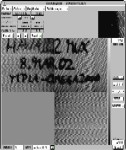 Mar. '02: First light with the MUX. One quadrant is not bonded.
Mar. '02: First light with the MUX. One quadrant is not bonded.
Mar. '02: First cool down experiments with the filter wheel unit and the instrument
control electronics.
Mar. '02: Impressive view at the beginning of a cool down cycle
Feb.02: Our cryo-engineer convinced us: the larger the dewar, the smaller
the pump! And it works.
Jan. 02: First integration of mechanics and cables in the final dewar. There
are three filter wheels with 7 positions each. The cables are feed through
the shields by light thight and thermal coupled connectors.

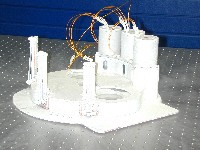 Dec. 01: Cryo-tests of the final filter wheel mechanism & motors. Unit
is working well in liquid nitrogen.
Dec. 01: Cryo-tests of the final filter wheel mechanism & motors. Unit
is working well in liquid nitrogen.